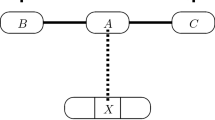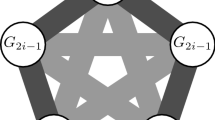Abstract
Given two graphs G and H, the k-colored Gallai–Ramsey number \(gr_k(G : H)\) is defined to be the minimum integer n such that every k-coloring of the complete graph on n vertices contains either a rainbow copy of G or a monochromatic copy of H. In this paper, we consider \(gr_k(K_3 : H)\), where H is a connected graph with five vertices and at most six edges. There are in total thirteen graphs in this graph class, and the Gallai–Ramsey numbers for eight of them have been studied step by step in several papers. We determine all the Gallai–Ramsey numbers for the remaining five graphs, and we also obtain some related results for a class of unicyclic graphs. As applications, we find the mixed Ramsey spectra \(S(n; H, K_3)\) for these graphs by using the Gallai–Ramsey numbers.

Similar content being viewed by others
Change history
03 October 2020
The following items are the errors that should be corrected.
References
Axenovich, M., Choi, J.: On colorings avoiding a rainbow cycle and a fixed monochromatic subgraph. Electron. J. Combin. 17(Research Paper 31), 15 (2010)
Axenovich, M., Choi, J.: A note on the monotonicity of mixed Ramsey numbers. Discret. Math. 311, 2020–2023 (2011)
Burr, S.A., Roberts, J.A.: On Ramsey numbers for stars. Utilitas Math. 4, 217–220 (1973)
Chen, M., Li, Y.S., Pei, C.P.: Gallai-Ramsey numbers of odd cycles and complete bipartite graphs. Graphs Combin. 34, 1185–1196 (2018)
Chung, F.R.K., Graham, R.: Edge-colored complete graphs with precisely colored subgraphs. Combinatorica 3, 315–324 (1983)
Faudree, R.J., Gould, R., Jacobson, M., Magnant, C.: Ramsey numbers in rainbow triangle free colorings. Aust. J. Combin. 46, 269–284 (2010)
Fujita, S., Magnant, C.: Gallai–Ramsey numbers for cycles. Discret. Math. 311, 1247–1254 (2011)
Fujita, S., Magnant, C.: Extensions of Gallai–Ramsey results. J. Graph Theory 70, 404–426 (2012)
Fujita, S., Magnant, C., Ozeki, K.: Rainbow generalizations of Ramsey theory: a survey. Graphs Combin. 26, 1–30 (2010)
Fujita, S., Magnant, C., Ozeki, K.: Rainbow generalizations of Ramsey theory: a dynamic survey. Theory Appl. Graphs 0, Article 1 (2014)
Gallai, T.: Transitiv orientierbare Graphen. Acta Math. Acad. Sci. Hungar. 18, 25–66 (1967)
Gyárfás, A., Sárközy, G.N., Sebő, A., Selkow, S.: Ramsey-type results for Gallai colorings. J. Graph Theory 64, 233–243 (2010)
Gyárfás, A., Simonyi, G.: Edge colorings of complete graphs without tricolored triangles. J. Graph Theory 46, 211–216 (2004)
Hall, M., Magnant, C., Ozeki, K., Tsugaki, M.: Improved upper bounds for Gallai–Ramsey numbers of paths and cycles. J. Graph Theory 75, 59–74 (2014)
Hendry, G.R.T.: Ramsey numbers for graphs with five vertices. J. Graph Theory 13, 245–248 (1989)
Li, X.H., Wang, L.G., Liu, X.X.: Complete graphs and complete bipartite graphs without rainbow path. Discret. Math. 342, 2116–2126 (2019)
Maffray, F., Preissmann, M.: A translation of Tibor Gallai’s paper: transitiv orientierbare Graphen. In: Ramirez-Alfonsin, J.L., Reed, B.A. (eds.) Perfect Graphs, pp. 25–66. Wiley, New York (2001)
Mao, Y.P., Wang, Z., Magnant, C., Schiermeyer, I.: Gallai–Ramsey numbers for fans. arXiv:1902.10706
Radziszowski, S.P.: Small Ramsey numbers. Electron J. Combin. 1, Dynamic Survey 1, (electronic) (2017)
Song, Z.-X., Zhang, J.M.: A conjecture on Gallai–Ramsey numbers of even cycles and paths. arXiv:1803.07963
Wang, Z., Mao, Y.P., Magnant, C., Zou, J.Y.: Ramsey and Gallai–Ramsey numbers for two classes of unicyclic graphs. arXiv:1809.10298
Wu, H.B., Magnant, C., Nowbandegani, P.S., Xia, S.M.: All partitions have small parts-Gallai-Ramsey numbers of bipartite graphs. Discret. Appl. Math. 254, 196–203 (2019)
Acknowledgements
The authors are grateful to the anonymous referees for their valuable comments, suggestions and corrections which improved the presentation of this paper.
Author information
Authors and Affiliations
Corresponding author
Additional information
Publisher's Note
Springer Nature remains neutral with regard to jurisdictional claims in published maps and institutional affiliations.
Supported by the National Natural Science Foundation of China (No. 11871398), the Natural Science Basic Research Plan in Shaanxi Province of China (Program No. 2018JM1032), the Fundamental Research Funds for the Central Universities (No. 3102019ghjd003), and China Scholarship Council (No. 201906290174).
The original version of this article was revised: In the Original publication of the article, few errors have occurred. The corrections are given below:
1. Page 3, Theorem 2:
\( gr_k(K_3 : F_9)=gr_k(K_3 : F_{10})= \left\{ \begin{array}{l} 8\cdot 5^{(k-2)/2}+1,\\ 4\cdot 5^{(k-1)/2}+1,. \end{array} \right. \)
should be
\( gr_k(K_3 : F_9)=gr_k(K_3 : F_{10})= \left\{ \begin{array}{ll} 8\cdot 5^{(k-2)/2}+1,& \text{ if } k \text{ is } \text{ even},\\ 4\cdot 5^{(k-1)/2}+1,& \text{ if } k \text{ is } \text{ odd}. \end{array} \right. \)
2. Page 3, Theorem 4 (3):
\(k(n-1)+2 \ge gr_k(K_3 : F_{2,n})\ge \left\{ \begin{array} {l} \frac{5n}{2}+k-6, \\ \frac{5n-1}{2}+k-4, \end{array} \right. \)
should be
\(k(n-1)+2 \ge gr_k(K_3 : F_{2,n})\ge \left\{ \begin{array} {ll} \frac{5n}{2}+k-6,& \text{ if } n \text{ is } \text{ even},\\ \frac{5n-1}{2}+k-4,& \text{ if } n \text{ is } \text{ odd}. \end{array} \right. \)
3. Page 4, Theorem 5:
\( gr_k(K_3 : F_{12})=gr_k(K_3 : F_{13})= \left\{ \begin{array}{l} 9\cdot 5^{(k-2)/2}+1, \\ 4\cdot 5^{(k-1)/2}+1, \end{array} \right.\)
should be
\( gr_k(K_3 : F_{12})=gr_k(K_3 : F_{13})= \left\{ \begin{array}{ll} 9\cdot 5^{(k-2)/2}+1,&\text{ if } k \text{ is } \text{ even},\\4\cdot 5^{(k-1)/2}+1,&\text{ if } k \text{ is } \text{ odd}. \end{array} \right. \)
4. Page 5, Lemma 2:
\(gr_k(K_3 : K_3)= \left\{ \begin{array}{l}5^{k/2}+1,\\2\cdot 5^{(k-1)/2}+1, \end{array} \right.\)
should be
\(gr_k(K_3 : K_3)= \left\{ \begin{array}{ll} 5^{k/2}+1,&\text{ if } k \text{ is } \text{ even},\\2\cdot 5^{(k-1)/2}+1,&\text{ if } k \text{ is } \text{ odd}. \end{array} \right.\)
5. Page 5, Lemma 3:
\(gr_k(K_3 : F_9)> \left\{ \begin{array}{l}8\cdot 5^{(k-2)/2},\\4\cdot 5^{(k-1)/2}, \end{array} \right.\)
should be
\(gr_k(K_3 : F_9)> \left\{ \begin{array}{ll}8\cdot 5^{(k-2)/2},&\text{ if } k \text{ is } \text{ even},\\4\cdot 5^{(k-1)/2},&\text{ if } k \text{ is } \text{ odd}. \end{array} \right.\)
6. Page 5, Lemma 4:
\(gr_k(K_3 : F_{10})\le \left\{ \begin{array}{l}8\cdot 5^{(k-2)/2}+1,\\4\cdot 5^{(k-1)/2}+1, \end{array} \right.\)
should be
\(gr_k(K_3 : F_{10})\le \left\{ \begin{array}{ll}8\cdot 5^{(k-2)/2}+1,&\text{ if } k \text{ is } \text{ even},\\4\cdot 5^{(k-1)/2}+1,&\text{ if } k \text{ is } \text{ odd}. \end{array} \right.\)
7. Page 5, Proof of lemma 4:
\(n = \left\{ \begin{array}{l}8\cdot 5^{(k-2)/2}+1,\\4\cdot 5^{(k-1)/2}+1, \end{array} \right.\)
should be
\(n = \left\{ \begin{array}{ll}8\cdot 5^{(k-2)/2}+1,&\text{ if } k \text{ is } \text{ even},\\4\cdot 5^{(k-1)/2}+1,&\text{ if } k \text{ is } \text{ odd}. \end{array} \right.\)
8. Page 6:
\(gr_{k-1}(K_3 : K_3)= \left\{ \begin{array}{l}2\cdot 5^{(k-2)/2}+1,\\5^{(k-1)/2}+1, \end{array} \right.\)
should be
\(gr_{k-1}(K_3 : K_3)= \left\{ \begin{array}{ll}2\cdot 5^{(k-2)/2}+1,&\text{ if } k \text{ is } \text{ even},\\5^{(k-1)/2}+1,&\text{ if } k \text{ is } \text{ odd}. \end{array} \right. \)
9. Page 9:
\( |V(G_k)|= \left\{ \begin{array}{l} \frac{5n}{2}+k-7,\\ \frac{5n-1}{2}+k-5, \end{array} \right. \)
should be
\( |V(G_k)|= \left\{ \begin{array}{ll}\frac{5n}{2}+k-7,&\text{ if } n \text{ is } \text{ even},\\ \frac{5n-1}{2}+k-5,&\text{ if } n \text{ is } \text{ odd}. \end{array} \right. \)
10. Page 9:
\( n_{k}= \left\{ \begin{array}{l} r_2(F_{2,n})+k-2,\\ k+9,\\k(n-1)+2, \end{array} \right. \)
should be
\( n_{k}= \left\{ \begin{array}{lll}r_2(F_{2,n})+k-2,&\text{ if } n \in \{3,4\} \text{ and } k\ge 1,\\k+9,&\text{ if } n=5 \text{ and } k\ge 2,\\k(n-1)+2,&\text{ if } n \ge 6 \text{ and } k\ge 2. \end{array} \right. \)
11. Page 11, Lemma 6:
\( gr_k(K_3 : H)> \left\{ \begin{array}{l}9\cdot 5^{(k-2)/2},\\4\cdot 5^{(k-1)/2}, \end{array} \right. \)
should be
\( gr_k(K_3 : H)> \left\{ \begin{array}{ll}9\cdot 5^{(k-2)/2},&\text{ if } k \text{ is } \text{ even},\\4\cdot 5^{(k-1)/2},&\text{ if } k \text{ is } \text{ odd}. \end{array} \right. \)
12. Page 11–12, Lemma 7:
\( gr_k(K_3 : H)\le \left\{ \begin{array}{l}9\cdot 5^{(k-2)/2}+1,\\4\cdot 5^{(k-1)/2}+1, \end{array} \right. \)
should be
\(gr_k(K_3 : H)\le \left\{ \begin{array}{ll}9\cdot 5^{(k-2)/2}+1,&\text{ if } k \text{ is } \text{ even},\\4\cdot 5^{(k-1)/2}+1,&\text{ if } k \text{ is } \text{ odd}. \end{array} \right. \)
13. Page 12, Proof of Lemma 7:
\( n= \left\{ \begin{array}{l}9\cdot 5^{(k-2)/2}+1,\\4\cdot 5^{(k-1)/2}+1, \end{array} \right. \)
should be
\( n= \left\{ \begin{array}{ll}9\cdot 5^{(k-2)/2}+1,&\text{ if } k \text{ is } \text{ even},\\4\cdot 5^{(k-1)/2}+1,&\text{ if } k \text{ is } \text{ odd}. \end{array} \right. \)
Rights and permissions
About this article
Cite this article
Li, X., Wang, L. Gallai–Ramsey Numbers for a Class of Graphs with Five Vertices. Graphs and Combinatorics 36, 1603–1618 (2020). https://doi.org/10.1007/s00373-020-02194-5
Received:
Revised:
Published:
Issue Date:
DOI: https://doi.org/10.1007/s00373-020-02194-5




